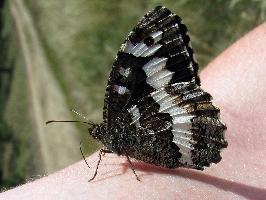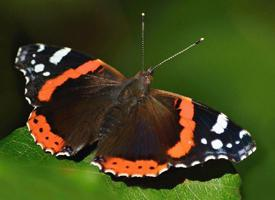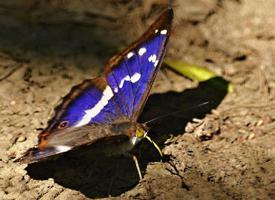
Súlyok és méretek
| Szárnyfesztávolság | 55-tól 65-ig mm |
|---|
Állatleírás
The Great Banded Grayling, scientifically known as Brintesia circe, is a fascinating species of butterfly that captivates the attention of both enthusiasts and researchers alike. This remarkable insect belongs to the Nymphalidae family, which is known for its diverse and vibrant members. The Great Banded Grayling, with its distinctive appearance and intriguing behaviors, stands out as a particularly interesting subject within this family.Adults of this species exhibit a wingspan that typically ranges between 55 to 65 millimeters, making them a medium-sized butterfly. The most striking feature of the Great Banded Grayling is undoubtedly its wing pattern. The dorsal side of the wings boasts a deep, velvety brown color, serving as a backdrop for a prominent white band that stretches across the forewings and hindwings. This band, combined with a series of smaller white spots and markings, creates a stark contrast that is both elegant and eye-catching. The ventral side of the wings presents a more subdued appearance, with cryptic coloration that allows the butterfly to blend seamlessly into its surroundings when at rest.
The habitat of the Great Banded Grayling is quite specific, with a preference for warm, dry areas. These butterflies are typically found in open woodlands, grasslands, and scrubby areas, where they can bask in the sunlight. They are predominantly seen in Southern and Eastern Europe, extending into Asia, and are known for their selective distribution, favoring regions that provide the optimal conditions for their survival and reproduction.
One of the most fascinating aspects of the Great Banded Grayling's behavior is its basking habit. Unlike many other butterfly species that prefer to bask with open wings, the Great Banded Grayling often basks with its wings closed, showcasing the cryptic underside of its wings. This behavior not only aids in thermoregulation but also serves as an effective camouflage against predators.
The lifecycle of the Great Banded Grayling, from egg to adult, is a testament to the resilience and adaptability of this species. Females lay their eggs on the leaves of specific host plants, with a preference for various grass species. Upon hatching, the caterpillars feed on the host plant, gradually growing and passing through several instar stages before pupating. The chrysalis stage is a time of transformation, culminating in the emergence of the adult butterfly, ready to continue the cycle of life.
In terms of conservation status, the Great Banded Grayling is not currently listed as endangered. However, like many species, it faces threats from habitat destruction, climate change, and other environmental pressures. Conservation efforts focused on preserving natural habitats and promoting biodiversity are crucial to ensuring the survival of this and countless other insect species.
In conclusion, the Great Banded Grayling is a remarkable butterfly that captures the imagination with its striking appearance and intriguing behaviors. Its presence in the ecosystem is a reminder of the intricate web of life and the importance of conservation efforts to preserve the natural world for future generations.
Hasonló állatok
Új állatfotók
Top 10 állat
- Dolphin gull (Leucophaeus scoresbii)
- Diana monkey (Cercopithecus diana)
- Japanese macaque (Macaca fuscata)
- Stone loach (Barbatula barbatula)
- Galápagos tortoise (Geochelone nigra complex)
- Moustached guenon (Cercopithecus cephus)
- Russian tortoise (Testudo horsfieldii)
- Japanese spider crab (Macrocheira kaempferi)
- Common house mosquito (Culex pipiens)
- Giant peacock moth (Saturnia pyri)


